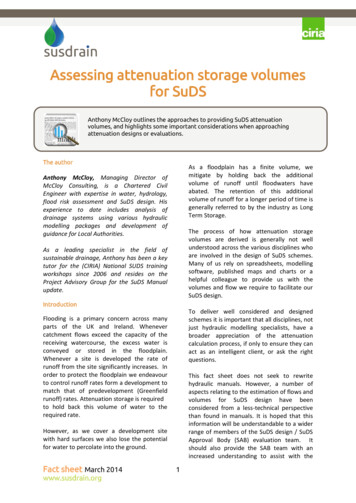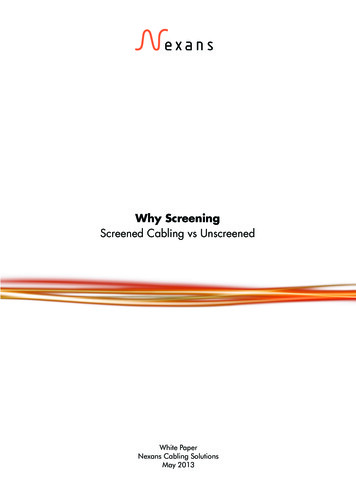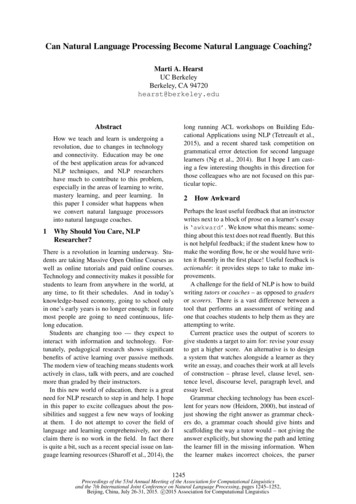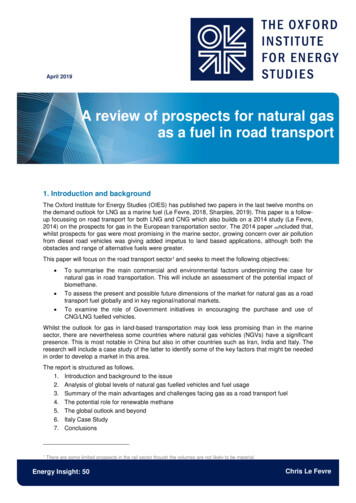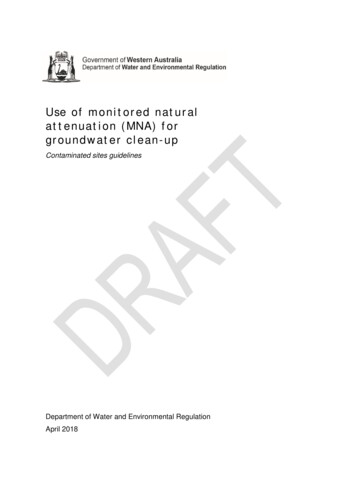
Transcription
Use of monitored naturalattenuation (MNA) forgroundwater clean-upContaminated sites guidelinesDepartment of Water and Environmental RegulationApril 2018
Department of Water and Environmental Regulation168 St Georges TerracePerth Western Australia 6000Telephone 61 8 6364 7000Facsimile 61 8 6364 7001National Relay Service 13 36 77www.dwer.wa.gov.au Government of Western AustraliaApril 2018This work is copyright. You may download, display, print and reproduce this material in unaltered formonly (retaining this notice) for your personal, non-commercial use or use within your organisation.Apart from any use as permitted under the Copyright Act 1968, all other rights are reserved. Requestsand inquiries concerning reproduction and rights should be addressed to the Department of Water andEnvironmental Regulation.DisclaimerThis document has been published by the Department of Water and Environmental Regulation. Anyrepresentation, statement, opinion or advice expressed or implied in this publication is made in goodfaith and on the basis that the Department of Water and Environmental Regulation and its employeesare not liable for any damage or loss whatsoever which may occur as a result of action taken or nottaken, as the case may be in respect of any representation, statement, opinion or advice referred toherein. Professional advice should be obtained before applying the information contained in thisdocument to particular circumstances.This publication is available at our website www.dwer.wa.gov.au or for those with special needs itcan be made available in alternative formats such as audio, large print, or Braille
Contaminated Sites GuidelineApril 2018ContentsContents . iii1 Purpose .12 Introduction.22.12.2General .2Key terms .22.2.1 Site 22.2.2 Source and affected sites .32.2.3 Contaminated .32.2.4 Definition of remediation .43 Monitored natural attenuation .54 Application and constraints.54.1MNA processes .5Figure 1. Assessing the environmental effects of groundwater contamination within a source-pathwayreceptor risk-assessment framework. .6Table 2 Dominant NA mechanisms for key groups of contaminants (adapted from EnvironmentAgency, 2004).74.24.3Weight of evidence approach .8Criteria for acceptance of MNA .95 Structured approach for implementing MNA. 115.1Overview of technical criteria.11Figure 3: Process for implementing MNA as a clean-up option at a site (adapted from EnvironmentAgency, 2000). 125.2Overview of socio-economic and administrative considerations .135.2.1 Introduction . 135.2.2 Consultation with relevant stakeholders . 135.2.3 Time-scale for clean-up . 135.2.4 Classification under the Contaminated Sites Act 2003 . 145.2.5 Sustainability considerations . 146 Stage 1 – screening process to assess the viability of MNA . 156.16.2Introduction .15Chemical properties of contaminants .15Figure 3: Shrinking of groundwater contamination plumes due to natural attenuation processes fororganic (destructive, irreversible NA processes) and inorganic contaminants (generally nondestructive, reversible NA processes). . 16Table 2. Applicability of MNA to key groups of chemical contaminants (Adapted from US Department ofEnergy, 2001) . 17Figure 4. Hierarchy of electron acceptors utilised by microorganisms in the biodegradation ofcontamination plumes caused by leaks of petroleum hydrocarbons . 196.3Aquifer properties .20Table 3 Typical values of hydraulic conductivity for sediments from the superficial aquifer on the SwanCoastal Plain (adapted from Davidson, 1995) . 216.4Regulatory and socio-economic constraints .217 Stage 2 – demonstrating natural attenuation at a site . 257.1Lines of evidence .257.1.1 Primary lines of evidence . 257.1.2 Secondary lines of evidence . 25Department of Water and Environmental Regulationiii
Contaminated Sites GuidelineApril 20187.1.3 Tertiary lines of evidence . 257.2Establishing a network of monitoring bores .26Figure 5.1. Minimum requirements for a groundwater monitoring network for MNA . 27Figure 5. Typical construction of a groundwater monitoring bore (Sundaram et al., 2009) . 28Table 5. Field indicators that may be used to identify the presence of groundwater contaminationduring a drilling program . 297.3Groundwater sampling procedures .30Figure 7. Sampling problems associated with the use of (a) high flow –rate pumps and (b) bailers orinertial pumps with a foot-valve (“jiggle” pumps). . 30Figure 8 Low-flow groundwater sampling showing laminar groundwater flow to the sampling pump andminimal drawdown of the water table . 317.4Groundwater sampling and analysis .32Table 6. Chemical parameters measured by field tests and laboratory analysis to provide evidence ofnatural attenuation (adapted from Environment Agency, 2000). . 337.5Sampling of aquifer solids .35Figure 9. Sampling of aquifer solids within a groundwater contamination plume to demonstrate arelationship between contaminant levels dissolved in groundwater and levels adsorbed orco-precipitated in minerals in the solid matrix (adapted from US EPA, 2007a). . 35Table 7. Chemical parameters measured by the analysis of aquifer solids to assess the ability of theaquifer matrix to attenuate contaminants in groundwater. . 377.6Assessing and presenting monitoring data .38Figure 10. Graph of concentration versus time showing a progressive decline in contaminantconcentrations over time in bores within a groundwater contamination plume near the plumeaxis (adapted from Wiedemeier, 2000). . 39Figure 11. Graph of contaminant concentrations versus distance along the plume axis showing theprogressive decrease of the severity of contamination over a three-year period (adaptedfrom Wiedemeier, 2000) . 40Table 8. Presentation of information to demonstrate natural attenuation (adapted from EnvironmentAgency, 2000). 40Figure 12. Establishing control-planes with transects of monitoring bores across a plume to measurechanges in the mass-flux of contaminants with time and distance from a contaminationsource. . 428 Stage 3 – predicting the long term viability of natural attenuation . 43Table 9. Examples of public-domain software tools for predicting the natural attenuation of organiccompounds in groundwater. 44Table 10. Examples of software tools for predicting the natural attenuation of inorganic constituents ingroundwater. . 459 Stage 4 – implementing a performance monitoring program . 489.19.29.3Introduction .48Reviewing the existing network of monitoring bores .49Groundwater sampling and frequency of monitoring .50Table 11. Performance monitoring schedule for well-characterised sites with a negligible risk ofadverse impacts on environmental receptors and environmental values (adapted fromWashington State Department of Ecology, 2005) . 519.49.5Contingency measures and triggers.51Attainment of remediation objectives .52References . 54Appendix A Mann-Kendall test for assessing the statistical significance ofcontaminant concentration declines . 57Table A.1. Concentration – sampling time matrix for a Mann-Kendall test . 58Table A.2. Mann-Kendall look-up table for α 0.1 (90% confidence level). 59Department of Water and Environmental Regulationiv
Contaminated Sites GuidelineApril 2018APPENDIX B EXAMPLE OF A CONTAMINANT DEGRADATION MASS BALANCECALCULATION . 60Field data .60Table B.1Concentration data . 60Mass-balance approach .60Table B.2 Chemical processes involved in the biodegradation of toluene in groundwater . 61Table B.3 Stoichiometric ratios for the biodegradation of toluene . 61Table B.4 Computed Alkalinity and BTEX consumption . 62GLOSSARY . 63Department of Water and Environmental Regulationv
1PurposeThe purpose of this guideline is to provide guidance on the application of monitorednatural attenuation (MNA) for cleaning up groundwater at contaminated sites inWestern Australia. This guidance should be applied within the legislative frameworkprovided by: the Contaminated Sites Act 2003 (CS Act) and the Contaminated SitesRegulations 2006 (CS Regulations); and the revised national site assessmentframework provided in the National Environment Protection (Assessment of SiteContamination) Measure 1999 (NEPM).This guideline has been prepared to assist proponents and environmentalpractitioners, including environmental consultants and auditors, when planning andimplementing a programme of monitored natural attenuation and when preparing areport(s) to be submitted to the Department of Water and Environmental Regulation(DWER) and/or accredited contaminated site auditors under the CS Act and CSRegulations.This guideline sets out a staged assessment process that DER will requireproponents/practitioners to undertake in order to provide evidence that MNA will bean effective management option for contaminated groundwater at a given site.This document provides guidance on a staged approach to implementing MNA : Stage 1 – screening assessment to evaluate feasibility and acceptability Stage 2 – site characterisation and demonstrating MNA Stage 3 – predicting the long term viability of MNA Stage 4 – implementing performance monitoring and achieving closureInternational research over recent decades has shown that a variety of naturalprocesses that take place below the ground are capable of removing contaminantsfrom soil and groundwater. These contaminant removal mechanisms are collectivelyreferred to as Natural Attenuation (NA) and, under some circumstances, NA can beused as one of a number of measures for cleaning up contaminated groundwater.This guideline does not provide a detailed discussion of natural attenuationmechanisms for specific contaminant types or sources of contamination. Practitionersare referred to the references herein for further information on natural attenuationmechanisms.This guideline may also be useful for other purposes such as due diligenceassessments. However, it may also be necessary to discuss site-specificcircumstances with DWER, refer directly to the CS Act and CS Regulations and/orseek specific legal advice.Department of Water and Environmental Regulation1
2Introduction2.1GeneralDWER has prepared this guideline to help land owners, industry, consultants andauditors and other interested parties, understand the requirements for applyingmonitored natural attenuation to clean up groundwater at contaminated sites in WA.In WA, contaminated sites are regulated by DWER through the CS Act and CSRegulations (available from Parliamentary Counsel’s Office atwww.legislation.wa.gov.au). DWER works in consultation with the Department ofHealth in relation to public health issues at contaminated sites.The NEPM provides guidance on the assessment of site contamination and isavailable at tion. Whenreferring to the NEPM, practitioners should also consult this website for errata andadditional information provided in the NEPM toolbox. The National EnvironmentProtection Council Act 1994 limits the scope of the NEPM to site assessment andtherefore it does not include detailed guidance on remediation of contaminated sites.DWER provides additional guidance specific to WA within the Contaminated SitesGuidelines (CSG), which includes this guideline - available s are expected to refer to the NEPM and DWER guidelines whenconducting site assessments and remediating contamination. It is essential thatpractitioners keep up to date with current versions of guidance documents referred toherein and published updates and/or errata.The Contaminated Sites Guidelines replace the guidelines within the formerContaminated Sites Management Series. Further information is available in DER(2014) and at tes/61contaminated-sites-guidelines?showall &start 1.2.2Key terms2.2.1 SiteSection 3 of the CS Act provides the following definition of a site:CS Act s 3 - definition of “site”“site” means an area of land and includes –(a)underground water under that land; and(b)surface water on that landA site must be identified by the boundaries identified under the relevant certificate(s)of title. This enables DWER to use the state land administration system to identifyand record known and suspected contaminated sites on the Contaminated SitesRegister and for lodging memorials under the CS Act.Department of Water and Environmental Regulation2
2.2.2 Source and affected sitesA site may comprise several land parcels or a single land parcel where thecontaminating activities occurred. The CS Act differentiates between sites wherecontamination has originated, and sites that have become contaminated due to themovement or migration of contamination from another site, i.e. the off-site movementof contaminated groundwater, surface water or soil. Section 3 of the CS Act definesthese types of sites as source sites and affected sites.CS Act s 3 - definition of “source site” and “affected site”“source site” means a site –(a) on which contamination; or(b) on which a substancehas originated and from which it has migrated to another site (the “affected site”)causing, or contributing to, contamination on that other site.“affected site” means a site on which contamination is caused, or contributed to –(a) by contamination; or(b) by a substance,which has migrated to that site from another site (the “source site”).2.2.3 ContaminatedSection 4(1) of the CS Act provides the following definition of contamination:CS Act s 4(1) - definition of “contaminated”“contaminated”, in relation to land, water or a site, means having a substancepresent in or on that land, water or site at above background concentrations thatpresents, or has the potential to present, a risk of harm to human health, theenvironment or any environmental value.Contamination can be present in the soil, groundwater or surface water of a site. Itmay be present in the solid, liquid or gaseous phases (e.g. soil or groundwatercontamination giving rise to contaminant vapours in soil pore spaces). Wheresubstances are present at above background concentrations, further assessment ofthose substances is required to assess the risk of harm to human health, theenvironment and environmental values.Section 4(2) of the CS Act provides for circumstances where sites are not consideredcontaminated, these are prescribed in regulation 5 of the CS Regulations. Furtherinformation is provided in DER (2017).Further information relevant to the definition of ‘contamination’ and risk of harm isprovided in DER (2014).Department of Water and Environmental Regulation3
2.2.4 Definition of remediationThe CS Act provides the following definition of remediation:CS Act s 3 - definition of “remediation”“remediation” in respect of a site that is contaminated includes –(a) the attempted restoration of the site to the state it was in before thecontamination occurred;(b) the restriction, or prohibition, of access to, or use of, the site;(c) the removal, destruction, reduction, containment or dispersal of the substance,causing the contamination, or the reduction or mitigation of the effect of thesubstance;(d) the protection of human health, the environment or any environmental valuefrom the contamination.Although the CS Act definition of remediation includes measures to managecontamination such as by restricting access or use of the site, the term ‘remediation’is commonly used in the literature to refer to active clean-up measures such astreating, removing or engineered means of containing contamination. The terms‘remediation’ and ‘management’ are also used interchangeably in the literature.The clean-up and management of contaminated sites are discussed in sections 12and 13 of DER (2014).Department of Water and Environmental Regulation4
3Monitored natural attenuationNatural Attenuation (NA) refers to naturally-occurring physical, chemical andbiological processes (or various combinations of these processes) that reduce themass, toxicity, mobility, volume or concentration of organic or inorganic contaminantsin groundwater (Environment Agency, 2000).Monitored natural attenuation (MNA)MNA refers to ongoing groundwater quality monitoring and associated field andlaboratory based research that is undertaken to demonstrate that NA is taking placeat a sufficiently rapid rate over a sufficient extent to protect sensitive environmentalreceptors from the effects of groundwater contamination.Organic contaminantsMNA has been widely used as a remedial measure for organic contaminants ingroundwater, primarily for managing contamination by petroleum hydrocarbons (Beckand Mann, 2010) and chlorinated solvents. This is because microbial processes insoils and aquifer sediments progressively break down these chemicals into harmlesssubstances, although toxic intermediary by-products such as vinyl chloride may beproduced in the case of chlorinated solvents. Under these conditions, there is a highdegree of certainty that the parent chemical compounds will be eventually completelyremoved from soils, aquifer sediments and groundwater over a period of time.Metals and metalloidsMore recent work (US EPA, 2007a,b; US EPA, 2017) has demonstrated that theprinciples of MNA can also be used for managing groundwater contamination bymetals and metalloids, particularly at abandoned or closed mine sites wherecontamination by these chemical constituents may persist for long periods of timeafter mining activities have ceased. However, although metals and metalloids maybe removed from groundwater by adsorption onto aquifer sediments or by similar NAprocesses, these chemicals are not actually removed from the system, and could bepotentially released back into groundwater if chemical conditions in an aquifer wereto change. As a consequence of this, there is typically a higher burden of proofrequired to demonstrate that MNA will be an effective remedial measure for metalsand metalloids than for other chemical constituents in groundwater where massremoval can be demonstrated with confidence.4Application and constraints4.1MNA processesMonitored Natural Attenuation is a risk-based approach to managing groundwatercontamination which considers the size and characteristics of the source ofcontamination, the characteristics of the groundwater pathway that transmits thecontaminants, and the presence and sensitivity of receptors that may be affected bygroundwater contamination (Figure1).Department of Water and Environmental Regulation5
Figure 1. Assessing the environmental effects of groundwater contaminationwithin a source-pathway-receptor risk-assessment framework.The severity of groundwater contamination at a given site and the ultimate extent of acontamination plume will depend on the degree to which factors that cause the plumeto grow (particularly the size of the contamination source and the hydraulic propertiesof the aquifer) are balanced by NA processes which typically retard the movement ofthe plume or cause the plume to shrink (Figure 1).The dominant NA processes that affect key groups of contaminants in groundwaterare summarised in Table 2.Department of Water and Environmental Regulation6
Table 2 Dominant NA mechanisms for key groups of contaminants (adapted from Environment Agency, 2004)Contaminant typeExamplesMethChlorinated solvents( 3 chlorine atoms)TCE ? Chlorinated solvents( 3 chlorine atoms)DCE PetroleumhydrocarbonsBTEX Fuel oxygenatesMTBE Metals (cationic)Hg, Cd, PbMetals (anionic)CrO4MetalloidsAs, ieldrin (Hg)Ppt & Sorpion exc (Se)VolatDepartment of Water and Environmental RegulationAn Deg DehalFerCometRedox Meth – MethylationPpt & ion exc – precipitation and ion exchangeVolat – VolatilisationAer Deg – Aerobic degradationDehal- DehalogenationFer – FermentationRedox – oxidation/reduction reactions - PROCESS IS OF PRIMARY IMPORTANCE ? - Some doubt exists about the importance of the processAerDeg ? ?Sorp – Sorption and bindingAn Deg – Anaerobic degradationComet – Co-metabolism- Process is of secondary importance7 ?
The purpose of MNA is to demonstrate, with monitoring and specific field- andlaboratory-based research, that NA processes are taking place at a sustainable andsufficient rate to prevent a groundwater contamination plume from affecting sensitiveenvironmental receptors such as water supply bores and aquatic environments thatreceive groundwater discharge (Figure 1). In general, natural attenuation processesare most likely to be effective in protecting receptors where the contamination sourcehas been removed or has been contained to prevent or minimise contaminantdischarge to groundwater.Dilution and MNADWER does not consider dilution of contaminants on discharge of groundwater toan aquatic environment to be an acceptable form of NA as impacts on benthicfauna may take place even if concentrations in the overlying water column arediluted to negligible levels. This is because organisms that live in sediments at theinterface between groundwater and a surface water body (the so-called ‘hyporheiczone’) could be subject to the impacts of the undiluted discharge of contaminantsby groundwater.In situations where groundwater contamination is discharged to a hydraulicallyclosed surface water environment such as a mine pit-lake, proponents/practitionersshould also consider the long-term effects of evaporation and water-rock reactions onwater quality and the potential environmental impacts on wildlife when consideringwhether MNA will be a suitable clean-up option under these circumstances.4.2Weight of evidence approachIt is not possible to conclusively prove whether particular NA processes are takingplace below the ground. Consequently, demonstrating that natural attenuation istaking place in groundwater relies on a “weight of evidence” approach. DWER willgenerally require that practitioners provide at least two lines of evidence todemonstrate that MNA will be a suitable clean-up option at a particular site. Therequired lines of evidence will generally include: documented decreases in the concentration and/or mass of contaminants ingroundwater over a period of time the presence of geochemical and biochemical indicators that indicate thenatural attenuation processes are taking place; and for most inorganic contaminants - sediments and/or weathered rock materialsin aquifers are capable of adsorbing and binding sufficient contaminants on asustainable basis to minimise their mobility in groundwater to prevent impactson sensitive human and environmental receptors.Evaluation of these lines of evidence requires a detailed understanding of thehydrogeology and geochemistry of the site.Department of Water and Environmental Regulation8
4.3Criteria for acceptance of MNAThe main criteria for the acceptance of MNA as a remedial option by DWER are: natural attenuation can be demonstrated with confidence; natural attenuation will protect sensitive receptors from contamination; natural attenuation can be effectively monitored; remedial objectives will be achieved in a reasonable time frame; and a contingency plan has been prepared and can be implemented if necessary. Natural attenuation can be demonstrated with confidenceFor biodegradable organic contaminants in simple groundwater systems, this willtypically require a minimum of two years of monitoring data from bores at the site,the development of a conceptual model of the processes that are occurring, andsufficient field and laboratory
Minimum requirements for a groundwater monitoring network for MNA.27 Figure 5. Typical construction of a groundwater monitoring bore (Sundaram et al., 2009).28 Table 5. Field indicators that may be used to identify the presence of groundwater contamination . National Environment Protection (Assessment of Site Contamination) Measure .

